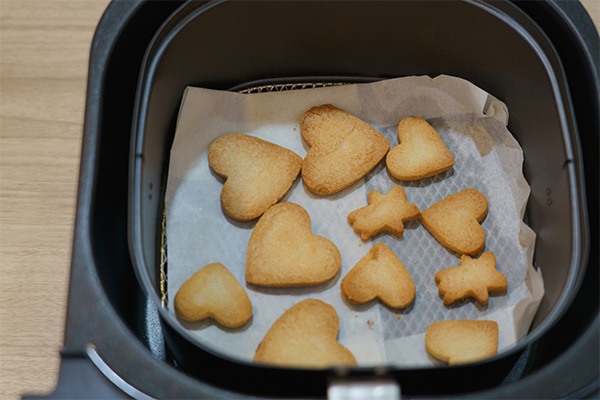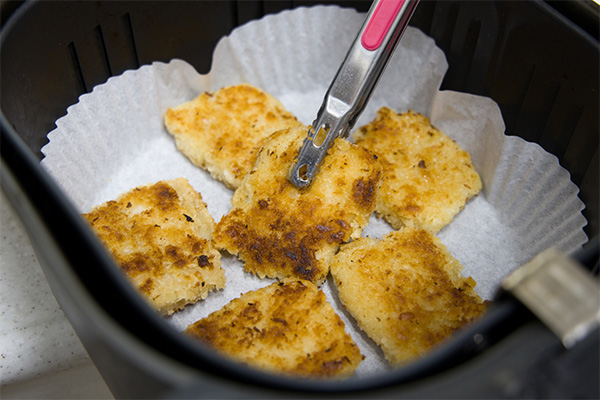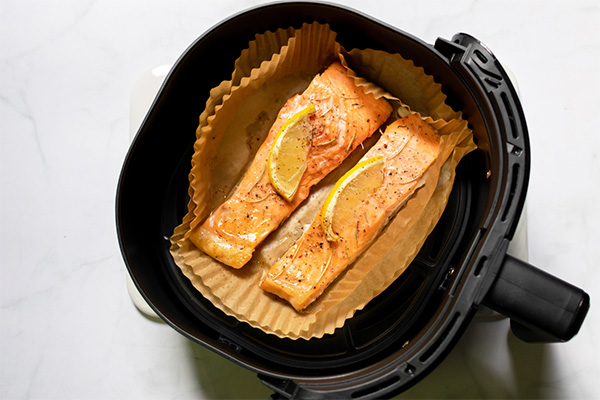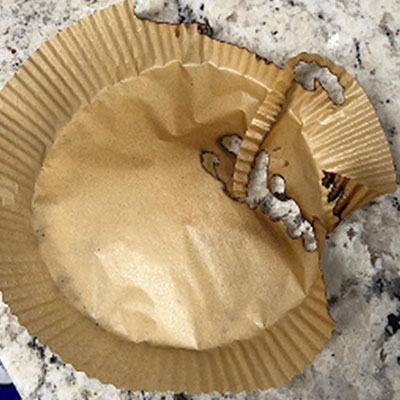Air fryers have become increasingly popular as both a handy and a healthy way to cook food! Air frying involves using hot air to cook food inside of the air fryer basket, giving it the crispy texture that once was only achievable using deep frying. However, cleaning an air fryer does demand some time and effort.
Many people turn to air fryer liners for easy cleanup. However, you might want to think again. There are many reasons why avoiding using air fryer liners in your air fryer or oven might be wiser! Below, we'll dive into some of those reasons so you can make an informed decision.

1. Health Concerns
It's important to be mindful of the surfaces our food comes into contact with as it cooks. Heat denatures some types of molecular bonds, causing them to leach into the food being cooked. This isn't a concern with all cooking surfaces, but it's wise to examine the materials used to make air fryer liners closely.
Silicone Air Fryer Liners
Silicone has emerged as a popular alternative to single-use plastic items, and this trend also extends to air fryer liners. These versatile silicone air fryer liners come in various styles and shapes. They are designed to fit your specific air fryer model perfectly and are dishwasher-safe to make cleaning a breeze. Some are even designed with raised lines so the oil can drip down and separate from your food. It's undoubtedly a positive step forward to have reusable air fryer liner options available, reducing the need for disposable alternatives.
However, it's essential to acknowledge that while silicone offers reusability and convenience, they are not the best air fryer liner. There are ongoing studies concerning its safety in cooking applications. As the use of silicone in the kitchen becomes more prevalent, experts are carefully examining its potential effects on food and health.
In 1979, the FDA determined silicon dioxides (the main element in silicone products) were generally considered safe in food-grade contexts. Since then, no follow-up studies have been conducted. In fact, studies have found that silicone products can leach siloxanes when combined with oils at high temperatures - like those used during cooking.
Non-Stick Parchment Paper

The other main type of air fryer liners, like air fryer disposable liners, are made out of parchment paper. Some parchment paper liners have an additional nonstick coating, and it makes users think these are the best air fryer liners to use.
However, the nonstick coating may contain harmful chemicals that can leach into food when heated to high temperatures, like those used in an air fryer. PFAS (per- and poly-fluoroalkyl substances) and PFOA (perfluorooctanoic acid) cannot be broken down by our bodies. They accumulate over time, leading to chronic health disorders. Not to mention, with the high temperature, you will risk parchment paper burning during the air frying process.
2. Reduced Air Circulation
For an air fryer to work, the heated air must be allowed to circulate and flow freely throughout the fryer. Air fryer liners can hinder air circulation in two ways.
High Sides
Some air fryer liners are designed with high sides. This prevents oil and grease from splattering along the interior side of the air fryer. However, these high sides also block air from getting to the food in the air fryer basket.
Lack Of Perforations
Some air fryer liners have holes to facilitate better air circulation. Others lack perforated holes but are admittedly the best at keeping mess at bay. However, there is a reason for the large openings in the air fryer basket—allowing air to blow across the cooking food! By blocking those openings and not adding perforated holes to promote airflow, liners will prevent food from crisping up properly.
3. Additional Cost

Budgets are getting tighter and tighter. Using an air fryer liner will add an additional cost to cooking with an air fryer. Air fryer paper liners are intended to be used once before being discarded. Even silicone air fryer liners will break down over time. It is important to consider whether there is room in the budget for the regular expense of air fryer liners.
4. Sustainability Concerns
It's a common misconception that even though paper air fryer liners are a single-use item, they quickly biodegrade - so they are no real detriment to the environment. However, this isn't quite true.
Regular parchment paper will decompose in three months under normal conditions. However, the parchment paper used in most air fryer liners has been sprayed with sulfuric acid to give it non-stick properties. This means that each liner will take at least six months before decomposing. It will eventually biodegrade, but think of the build-up of liners that occurs in those six months!
Silicone air fryer liners can be used multiple times and are more eco-friendly than paper liners in this comparison. However, if a silicone liner is ever thrown away, it will take anywhere from 50 to 500 years for it to biodegrade.
5. Incompatibility With Specific Air Fryer Model
There are many, many different types of air fryers, with different manufacturers producing fryers with slightly different shapes. Some air fryer liners are compatible with most air fryer basket shapes, but not all.
There will likely be a time of trial and error as you find a liner that fits your machine. Some air fryer models are specifically designed to only work with air fryer liners made by the same company, which significantly limits your choices.
6. Effect On Food Flavor And Texture

Because air fryer liners place an additional layer between the food and the hot air being used to cook it, they will necessarily affect how the food cooks. In general, all air fryer liners create a need to increase the cooking time for food to reach the desired level of crispness. However, some types of food won't come out the same, even if you increase the cooking time. For example, foods with breading or pastry exteriors won't reach the same crispness. They need to have direct contact with the heat of the air fryer basket to cook to the right texture.
7. Cook the Food Unevenly
Specifically, with air fryer liners made from a reusable silicone material, it's important to keep the thickness of the liner in mind. Heat can't penetrate thick silicone. This means thick silicone liners only allow heat to reach the food straight from the top. As A Result, it will prevent foods from cooking evenly. Thinner silicone liners don't have this problem.
8. Potential Melting And Burning

Using air fryer liners, especially paper ones, in air fryers raises potential melting and burning concerns. The powerful fans inside air fryers circulate hot air, and if the paper liner shifts and comes into direct contact with the heating element, it can ignite. Additionally, air fryer liners have temperature limits, which can melt if exposed to temperatures that exceed their heat resistance. Safety precautions should be taken when using any liners in air fryers to avoid potential hazards.

